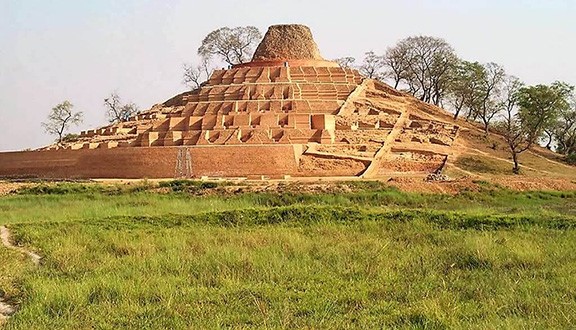Bihar Switch to Hindi
Kesariya Stupa
Why in News?
Kesariya Stupa is the largest Buddhist Stupa in the world. It is located in Kesariya, at a distance of 110 kilometers from Patna, in the East Champaran district of Bihar.
Key Points
- The first construction of the Stupa is dated to the 3rd century BCE. The original Kesaria stupa probably dates to the time of Ashoka (circa 250 BCE), as the remains of a capital of a Pillar of Ashoka were discovered there.
- The current stupa dates to the Gupta Dynasty between 200 AD and 750 AD and may have been associated with the 4th century ruler Raja Chakravarti.
- The stupa mound may even have been inaugurated during the Buddha's time, as it corresponds in many respects to the description of the stupa erected by the Licchavis of Vaishali to house the alms bowl the Buddha has given them.
- In ancient times, Kesaria was under the rule of the Mauryas and the Licchavis.
- Two great foreign travelers, Faxian (Fahien) and Xuan Zang (Hsuan Tsang), had visited this place in ancient times and have left interesting and informative accounts of their travels.
- The discovery of gold coins bearing the seal of the famous emperor Kanishka of the Kushan dynasty (AD 30 to AD 375) goes on to further establish the ancient heritage of Kesaria.
- Its exploration had started in the early 19th century after its discovery led by Colonel Mackenzie in 1814.
- Later, it was excavated by General Cunningham in 1861-62 and in 1998 an ASI team led by archaeologist K.K. Muhammad had excavated the site properly.
Madhya Pradesh Switch to Hindi
Impact of the Forest Rights Act on Land Conflicts
Why in News?
Recently, Land Conflict Watch, a data research agency, tracking land-related conflicts in India, has noted a significant correlation between land conflicts and the enforcement of the Forest Rights Act (FRA) 2006.
Key Points
- FRA enacted in 2006 recognises the rights of forest-dwelling tribal communities and other traditional forest dwellers to forest resources on which these communities were dependent for a variety of needs, including livelihood, habitation and other sociocultural needs.
- Out of the 781 conflicts documented in the Land Conflict Watch (LCW) database, a subset of 264 conflicts has been closely linked to parliamentary constituencies where the Forest Rights Act (FRA) is an important issue.
- These constituencies are commonly referred to as ‘FRA constituencies’ based on the People’s Forest report (by Centre for Science and Environment).
- Maharashtra, Odisha, and Madhya Pradesh have the highest number of core FRA constituencies.
- The states with the most forest rights issues in critical FRA constituencies are Odisha, Chhattisgarh, and the union territory of Jammu and Kashmir.
Status of Implementation of FRA
- Titles Accorded: As of February 2024, approximately 2.45 million titles have been granted to tribal and forest dwellers.
- However, out of five million claims received, about 34% have been rejected.
- Recognition Rate: Despite the vast potential, the actual recognition of forest rights has been limited. As of 31st August 2021, only 14.75% of the minimum potential forest areas eligible for forest rights have been recognised since the FRA came into force.
- State Variations:
- Andhra Pradesh: Recognized 23% of its minimum potential forest claim.
- Jharkhand: Recognized only 5% of its minimum potential forest area.
- Intra-State Variations: Even within states, recognition rates vary. For instance, in Odisha, while the district of Nabarangapur achieved a 100% IFR recognition rate, Sambalpur’s rate stands at 41.34%.
Uttar Pradesh Switch to Hindi
IIT Kanpur to Collaborate with Armed Forces Medical Services
Why in News?
Recently, The Armed Forces Medical Services (AFMS) signed a Memorandum of Understanding (MoU) for collaborative research and training with Indian Institute of Technology (IIT) Kanpur.
Key Points
- Under this AFMS and IIT Kanpur will collaborate to undertake research and development of new technologies to address health problems faced by soldiers in difficult terrains.
- It will also provide technical expertise for developing AI diagnostic models, at the Armed Forces Centre for Computational Medicine established in Armed Forces Medical College, which is first of its kind amongst medical colleges in India.
- Under the ambit of this MoU, faculty exchange program, joint academic activities and development of training modules will also be planned.
Armed Forces Medical Services (AFMS)
- The Armed Force Medical Services (AFMS) is an inter services organisation under the Ministry of Defense, covering the Indian Armed Forces.
- It came into existence in 1948.
Haryana Switch to Hindi
Rakhigarhi Findings
Why in News?
One of the recent changes in school textbooks proposed by the National Council of Educational Research and Training (NCERT) includes adding information about the results of Deoxyribonucleic acid (DNA) analysis on skeletal remains discovered at the ancient site of Rakhigarhi in Haryana.
- Additionally, references to the negative impact of the Narmada Dam project on tribals, causing displacement and increased poverty, have been removed.
Key Points
- NCERT has stated that study of ancient DNA from archaeological sources in Rakhigarhi, Haryana suggests that the genetic roots of the Harappans go back to 10,000 BCE.
- Rakhigarhi is the largest Harappan site in the Indian subcontinent. The site is situated in the plains of Saraswati river, about 27 km from the seasonal Ghaggar river.
- To study its evolution from 6000 BC (Pre-Harappan phase) to 2500 BC, excavations were carried out at Rakhigarhi under the leadership of Archaeological Survey of India (ASI) archaeologist Amarendra Nath.
- Prof. Shinde played an important role in the research related to Rakhigarhi. Prof. Shinde is also writing a book 'History of India' on these researches related to Indian history.
- Pro. Shinde said-
- The DNA report of the remains, evidence and skeletons found in the excavations at Rakhigarhi, Lothal Gilund, Nujat etc. has proved that the Harappan civilization was the oldest and most developed civilization in the world.
- The theory of Aryan invasion and coming from outside is fabricated and false, which has been confirmed on the basis of archaeological and scientific verification of DNA.
Archaeological Survey of India (ASI)
- ASI, under the Ministry of Culture, is the premier organization for the archaeological research and protection of the cultural heritage of the nation.
- It administers more than 3650 ancient monuments, archaeological sites and remains of national importance.
- Its activities include carrying out surveys of antiquarian remains, exploration and excavation of archaeological sites, conservation and maintenance of protected monuments etc.
- It was founded in 1861 by Alexander Cunningham- the first Director-General of ASI. Alexander Cunningham is also known as the “Father of Indian Archaeology”.
The National Council of Educational Research and Training
- It is an autonomous organization that was established in 1961 under the Societies Registration Act.
- It is the apex body for advising the central and state governments on matters related to school education.


.png)




.jpg)























.png)


.jpg)

 PCS Parikshan
PCS Parikshan


